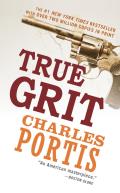Charles Portis’s
True Grit is a straightforward manhunt story elevated into a great American comic novel by the narrative voice.
The narrator is Mattie Ross, a fourteen-year-old determined to track down the man who killed her father and bring him to justice—at an affordable price. To do this she hires one-eyed deputy marshal Rooster Cogburn and forms an awkward alliance with Texas ranger LaBoeuf.
The very first paragraph ends with an accounting of the money Mattie’s father had on him when he was killed. Mattie knows that figure because she manages the business of the family farm. She speaks with the fiercest emotion when striking a financial bargain with horse traders, bounty hunters, and other men. At the end of the novel we learn that she’s grown up to run a private bank.
But Mattie Ross doesn’t want money for its sake, or for luxuries. She’s ready to endure privation and danger, defying the bounty hunters’ commands that she go home and leave the tracking to men. Money matters to Mattie because it’s how she measures fairness in the world, and fairness is her real concern.
Mattie is not out to make friends. She speaks bluntly and judgmentally to everyone she meets. She exasperates Cogburn and LaBoeuf until eventually they realize her integrity, and that they’re not getting rid of her. By the end of their trek, they risk their lives to save her. Then the three characters go their separate ways, never seeing each other again.
Others perceive the potential sexual tensions in a young girl traveling through unsettled territory with older men. LaBoeuf tells Mattie that he first thought she was pretty. But Mattie herself never shows any feel for sexual or romantic attractions. As an adult, she is a contented maiden lady.
I came to view the character of Mattie Ross through the lens of autism spectrum disorder, and I’m not the first to do so.
Caroline Narby wrote such an interpretation for Bitchmedia. This
Goodreads member named Stephanie did the same.
When Portis wrote
True Grit in 1968, pretty much only psychiatrists knew about autism, and the syndrome was widely attributed to “refrigerator mothers” and other nonsense. The term “Asperger syndrome,” which seems to be the closest category to describe Mattie’s character, wasn’t coined until 1976. The recognition that some people with autism function well in certain fields, such as financial analysis, while having trouble with everyday social relations was well in the future.
But goldurnit if Mattie Ross doesn’t come off as one of the most incisive portraits of a character on the autism spectrum. While she looks for “true grit” in Cogburn, she demonstrates that integrity, drive, and unwillingness to compromise in herself.
There have been two movie versions of
True Grit, the first made in 1969 when the book was still new. John Wayne played Rooster Cogburn as a semi-parodic version of his usual persona and won an Oscar for his troubles. However, writer Marguerite Roberts, director Henry Hathaway, and actress Kim Darby never seem to have a handle on Mattie Ross’s character, portraying her as a teenager with the stubbornness of a child.
In contrast, Joel and Ethan Coen’s 2010 version of
True Grit is built around Mattie. The scene of the ferry crossing shows the difference: in the first movie, we arrive at the ferry with Cogburn and LaBoeuf and view Mattie’s crossing at a distance. In the second film, it’s the other way around.
Portis’s narrative voice and dialogue fit right into the Coens’ usual combination of high and low rhetoric. Hailee Steinfeld played Mattie with the right exasperating exactitude, her determination not childish but single-minded.
Parts of the first
True Grit movie are entertaining, but the second is really good. And the novel is a masterpiece.






